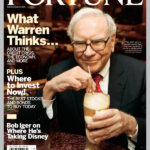For the past decade or so, it was easy for the average investor to pursue a winning strategy: Load up on low-cost ETFs that tracked the S&P 500 or another big basket of U.S. stocks, then sit back and watch the returns pile up. This strategy became even more appealing as the U.S. tech sector roared and the stock prices of “the Magnificent Seven” climbed to nosebleed heights. This approach, or variations on it, came to be known as Buy America, and it worked splendidly. Until it didn’t.
“If you’d come to me 10 years ago, I would have said, ‘Just buy an index fund and don’t worry about it,’” says Stephanie Guild, chief investment officer of Robinhood Markets. Now she suggests investors consider a more active approach to their portfolios—and give them a lot more geographic variety.
That advice is likely overstated, especially as some markets have recovered from the shock of the initial April tariffs. But the recent “Sell America” cries can also be seen as an exclamation point on a broader trend. According to many investment experts, it’s been apparent for some time that the lopsided weighting of tech stocks in many portfolios was not sustainable. And many casual investors may be unaware they’ve built up an oversize helping of Big Tech. Most index funds are asset-weighted, which means that the bigger the Magnificent Seven grew in market valuation, the more space in a set-it and-forget-it portfolio they came to occupy.
“The Magnificent Seven are truly magnificent, but they’ve become outsize and very expensive,” says Erik Knutzen, a co–chief investment officer at Neuberger Berman. As for recent asset flight away from U.S. stocks: “We don’t think this is some kind of dire perspective on the U.S.—more of a normal, rational rebalancing.”
For retail stock owners, the sudden shift is a reminder of one of the bedrock principles of investing: diversification. Research shows that more diverse portfolios perform better over the long run because a decline in one category of assets will typically be mitigated or offset by the performance of other assets. “This year has been a powerful reminder that you don’t want to let yourself get too concentrated in any one industry or asset class, no matter how bright it might shine at the moment,” says Katie Klingensmith, chief investment strategist at Edelman Financial Engines.
So if a passive strategy centered on U.S. assets is no longer optimal, what should investors
do instead?
The case for bonds, though, may be weaker. Robinhood’s Guild says the conventional wisdom that calls for steadily increasing the proportion of bonds in one’s portfolio as one gets older has become outdated. She points out that bond volatility has increased and it’s no longer a given that bonds’ returns will display a negative correlation to stocks.
Meanwhile, a series of developments are underway abroad—some of them hastened by economic and geopolitical disruptions unleashed by Trump—that are lifting some investors’ outlook for stocks in Europe and Asia. Knutzen pointed to Germany, in particular, whose government has shifted away from a rigid fiscal policy to pursue broader spending on defense. Knutzen also says his firm is encouraged by pro-growth policies adopted by governments in France and Italy that are invigorating the private sector.
For those looking to build or rebalance a portfolio, Guild proposes different ideas based on age, investment goals, and risk tolerance. For most people around age 35, she suggests a mix of about 75% U.S. stocks balanced with a helping of European equities packaged in large-cap ETFs. To round it out, she’d consider adding Asian tech stocks and commodities such as gold or Bitcoin. The calculus for those on the cusp of retirement is different, since those investors will typically want lower risk and ready access to cash. For them, Guild recommends a more conventional portfolio of around 60% stocks and 40% bonds, though she adds the latter portions should consist primarily of short-duration bonds given the current volatility of the markets.
For self-directed investors, these calls for a more diverse and complicated portfolio may pose a challenge since it will likely mean wading into unfamiliar asset categories. Hiring an active manager offers a solution to this. As always, one should feel confident that doing so will deliver additional gains that exceed the fees they charge. The good news for considering an active approach is that many advisors’ fees are dropping as a growing number of financial institutions push into wealth management services, creating more competition. (Of course, those fees will never approach those of leading ETFs, which can be as low as five basis points.) Another benefit of working with advisors: They can talk you out of yanking all your money out of the markets during a rough week.
More broadly, investors should treat the market events of 2025 in the context of a return to basics. On fundamental principle of investing that came to be overlooked during the go-go days of Buy America is that diversification will strengthen any portfolio and help it withstand shocks ranging from tariffs and pandemics to the popping of bubbles. “We are working with clients of all types on making sure they don’t have too much concentration,” says Knutzen.
In the age of app-based stock buying, it’s easy to forget that there is one popular asset you can store in a safe or bury in your backyard: gold. It’s also beautiful: A handsome doubloon or gleaming ingot will fetch a lot more compliments than the bits of digital dust that make up the rest of your portfolio. On the downside, unlike owners of run-of-the-mill stocks, gold owners must pay significant sums to safely transport and store their holdings, and face a very real risk of robbery from burglars or shifty visitors. Gold has other drawbacks, too, of course: Unlike stocks or bonds, it provides no income yield, and physical gold is not always the easiest thing to convert to cash.
For casual investors who have caught a touch of gold fever, Fortune has listed the pros and cons of popular purchasing options below.
Typically issued by national governments. The American Gold Eagle coin and the Canadian Gold Maple Leaf are popular choices.
Pros: Beautiful to hold and admire.
Cons: More expensive than other options.
Typically sold in flat one-ounce rectangles imprinted with a company or government logo. You can also buy larger bars—often called ingots—that are primarily traded in wholesale markets.
Pros: As basic as it gets and cheaper than coins.
Cons: Still comes with a premium to order and ship.
Among the world’s most popular ETFs, these are shares in a trust that trades like a stock, backed by reserves of physical gold stored by a bank or financial institution.
Pros: By far the cheapest option.
Cons: Nothing shiny to behold; the gold is held by a third party.
This article originally appears in the June/July 2025 issue of Fortune with the headline “Tariffs have halted the ‘Buy America’ era. Here’s what to do next.”









